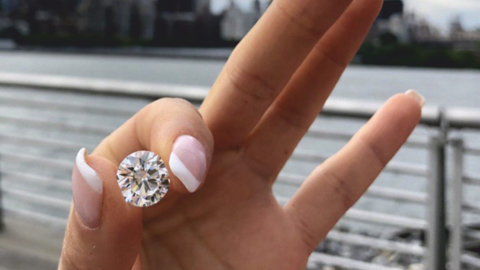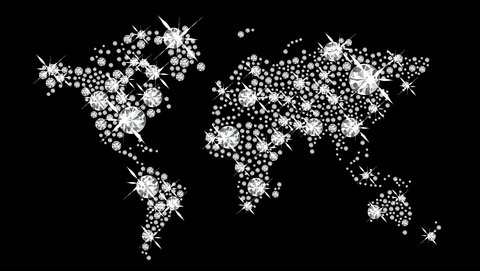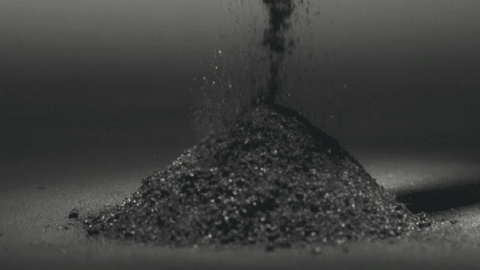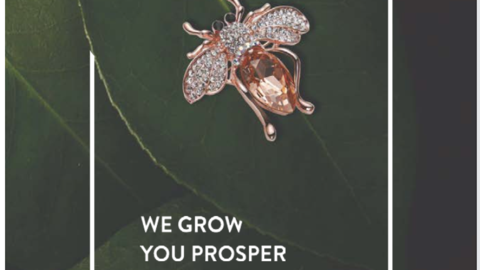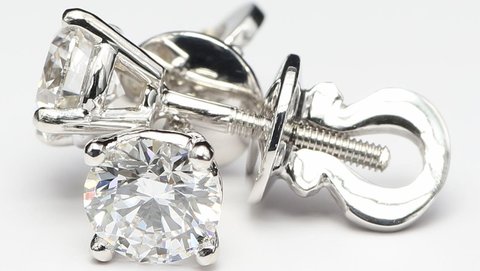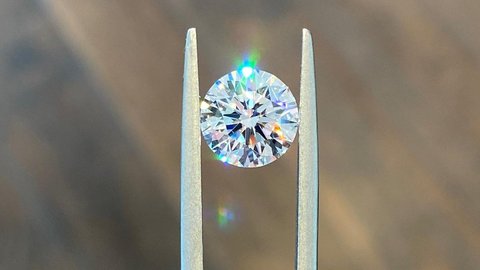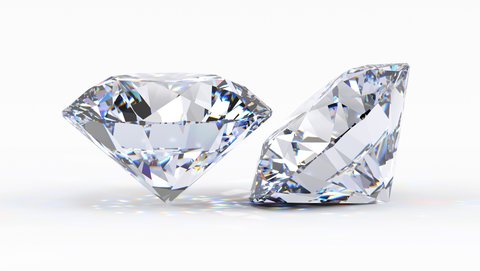VVS vs VS Lab-Grown Diamonds
VVS vs VS Lab-Grown Diamonds: Which Clarity Grade Offers the Best Value?
When shopping for the perfect lab-grown diamond, clarity stands as one of the crucial factors determining both beauty and price. For many discerning buyers, the choice often narrows down to VVS (Very Very Slightly Included) and VS (Very Slightly Included) clarity grades. These premium clarity grades offer exceptional brilliance, but understanding their subtle differences can save you thousands while still securing a stunning stone. At Labrilliante, we've created this comprehensive guide to help you navigate the nuanced world of diamond clarity and make a confident, informed purchase decision.

The Diamond Clarity Scale: What You Need to Know
Diamond clarity refers to the absence of inclusions (internal flaws) and blemishes (surface imperfections) in a diamond. The Gemological Institute of America (GIA) has established the industry standard clarity grading scale, ranging from Flawless (completely free of imperfections) to Included (imperfections visible to the naked eye).
The clarity scale progresses as follows:
- Flawless (FL) - No inclusions or blemishes visible under 10x magnification
- Internally Flawless (IF) - No inclusions, only minor blemishes under magnification
- Very Very Slightly Included (VVS1, VVS2) - Inclusions extremely difficult to see
- Very Slightly Included (VS1, VS2) - Minor inclusions difficult to see
- Slightly Included (SI1, SI2) - Inclusions noticeable under magnification
- Included (I1, I2, I3) - Inclusions visible to the naked eye
Understanding this scale is essential because clarity dramatically impacts a diamond's value and appearance. While the highest clarity grades command premium prices, the differences between certain grades may not be visible without specialized equipment. This creates opportunities for savvy buyers to maximize their budget without sacrificing visual beauty.

VVS Lab-Grown Diamonds: Exceptional Clarity with Premium Appeal
VVS (Very Very Slightly Included) diamonds represent the pinnacle of accessible luxury in the clarity spectrum. These remarkable gems contain minute inclusions that are so tiny that even experienced gemologists struggle to locate them under 10x magnification. At Labrilliante, our collection of VVS lab-grown diamonds exemplifies extraordinary craftsmanship and optical performance.
VVS1 vs VVS2: Understanding the Subtle Differences
The VVS category is further divided into two subgrades:
- VVS1: Inclusions are extremely difficult to detect under 10x magnification, even for skilled gemologists. These inclusions are typically visible only from the pavilion (bottom) of the diamond.
- VVS2: Inclusions remain extremely difficult to detect but are slightly more noticeable than in VVS1 diamonds. They may be visible from the crown (top) under magnification.
In both cases, these inclusions are completely invisible to the naked eye and have no impact on the diamond's fire, brilliance, or overall appearance without professional equipment.
Characteristics of VVS Lab-Grown Diamonds
VVS lab-grown diamonds from Labrilliante typically contain:
- Microscopic crystal inclusions
- Tiny pinpoint inclusions (appearing as white dots)
- Minute feathers (small internal fractures)
- Occasional needle-like structures
These inclusions are so minuscule that they're virtually impossible to locate without significant magnification and ideal lighting conditions. To the unaided eye, VVS diamonds appear flawless and deliver exceptional brilliance and fire.
Price Positioning of VVS Lab-Grown Diamonds
VVS clarity diamonds command a significant premium over lower clarity grades due to their rarity and exceptional quality. At Labrilliante, our lab-grown VVS diamonds typically range from approximately $1,200 to $2,800 per carat (depending on color, cut, and specific clarity grade), offering exceptional value compared to mined diamonds of similar quality.

VS Lab-Grown Diamonds: Exceptional Value Without Compromising Beauty
VS (Very Slightly Included) diamonds represent an outstanding balance between premium clarity and value. These remarkable gems contain minor inclusions that are difficult for trained gemologists to locate under 10x magnification, yet they cost significantly less than their VVS counterparts. At Labrilliante, our collection of VS lab-grown diamonds offers exceptional brilliance at an attractive price point.
VS1 vs VS2: Key Distinctions Worth Understanding
The VS category is divided into two important subgrades:
- VS1: Inclusions are difficult to detect under 10x magnification and require experienced gemologists to locate. These inclusions are typically small and positioned in less noticeable areas of the diamond.
- VS2: Inclusions remain difficult to detect but are slightly more visible than in VS1 diamonds. They may be somewhat larger or more numerous, but still require magnification to identify.
In both VS1 and VS2 diamonds, inclusions remain completely invisible to the naked eye and have no impact on the diamond's fire, brilliance, or visual performance in normal viewing conditions.
Characteristics of VS Lab-Grown Diamonds
VS lab-grown diamonds from Labrilliante typically contain:
- Small crystal inclusions
- Pinpoint clusters (groups of tiny white dots)
- Minor feathers (small internal fractures)
- Occasional small clouds (groups of pinpoints)
While these inclusions are identifiable under proper magnification, they remain invisible without specialized equipment. To the unaided eye, VS diamonds appear just as flawless as higher clarity grades, delivering exceptional sparkle and brilliance.
Price Positioning of VS Lab-Grown Diamonds
VS clarity diamonds offer exceptional value, typically costing 15-30% less than VVS diamonds of similar specifications. At Labrilliante, our lab-grown VS diamonds generally range from approximately $900 to $2,200 per carat (depending on color, cut, and specific clarity grade), making them an extremely popular choice for savvy buyers seeking maximum value.
VVS vs VS Diamonds: Side-by-Side Comparison
To help you make the most informed decision for your investment, we've created this comprehensive comparison of VVS and VS lab-grown diamonds. This detailed breakdown highlights the key differences and similarities between these popular clarity grades.
VVS vs VS Diamonds: Side-by-Side Comparison
| Feature | VVS Diamonds (VVS1 & VVS2) | VS Diamonds (VS1 & VS2) |
|---|---|---|
| Definition | Very Very Slightly Included - contains minuscule inclusions extremely difficult to see under 10x magnification | Very Slightly Included - contains minor inclusions that are difficult to see under 10x magnification |
| Position on GIA Scale | 3rd-4th highest clarity grades | 5th-6th highest clarity grades |
| Inclusion Visibility | Extremely difficult for experts to locate even under magnification | Difficult but possible for experts to locate under magnification |
| Eye-Cleanliness | 100% eye-clean | 100% eye-clean |
| Impact on Brilliance | No impact on visual brilliance | No impact on visual brilliance |
| Typical Price Range (1ct) | $1,200-$2,800 | $900-$2,200 |
| Price Premium | 15-30% higher than VS | 15-30% lower than VVS |
| Best Setting Styles | All setting styles; particularly stunning in minimalist solitaire settings | All setting styles; versatile for any design |
| Investment Potential | Excellent long-term value retention | Very good value retention with better initial value |
| Certification Importance | Essential - GIA or IGI certification recommended | Essential - GIA or IGI certification recommended |
Key Takeaways from the Comparison
At Labrilliante, we find that while both VVS and VS lab-grown diamonds offer exceptional clarity and brilliance, VS diamonds typically provide superior value for most buyers. The price difference between these grades is substantial, yet there is no visible difference to the naked eye. This makes VS diamonds particularly attractive for engagement rings and other significant purchases where maximizing the visual impact of your budget is important.


Seeing is Believing: Visual Comparisons and Real-World Examples
Understanding the subtle differences between VVS and VS diamonds becomes much clearer when examining them through practical examples. At Labrilliante, we've helped thousands of clients make informed decisions by demonstrating how these clarity grades appear in various real-world scenarios.
Under the Microscope: What Experts See
When viewed under 10x magnification (the standard for diamond grading), the differences between VVS and VS diamonds become apparent to trained gemologists:
- VVS Diamonds: Inclusions appear as tiny pinpoints or minute feathers that take significant time and expertise to locate. Even under magnification, these inclusions are challenging to find.
- VS Diamonds: Inclusions appear as small crystals, pinpoint clusters, or minor feathers that experienced gemologists can locate with less difficulty, but still require careful examination.


In Natural Light: What Customers Experience
The crucial revelation for most Labrilliante customers is how these diamonds appear in everyday situations:
- In Daylight: Both VVS and VS diamonds display identical brilliance and fire. Without magnification, neither shows any visible inclusions.
- Under Store Lighting: Even under the intense, direct lighting of a jewelry store, both clarity grades appear flawless to the naked eye.
- In Candlelight: During romantic dinners or special occasions, both VVS and VS diamonds capture and reflect light identically.
Real Customer Experiences
At Labrilliante, we regularly conduct blind comparisons with customers, placing identical-sized VS and VVS lab-grown diamonds side by side. In our experience:
- Over 99% of customers cannot distinguish between VS and VVS diamonds without magnification
- When informed of the price difference, approximately 85% of customers select the VS diamond
- Those who choose VVS typically do so for symbolic reasons rather than visual differences
"When I contacted Labrilliante, I was convinced I needed a VVS diamond for my engagement ring. After learning about both clarity grades in details and about the price difference, I chose a VS1 diamond that was 0.3 carats larger for the same budget. Three years later, I still can't see any inclusions, and I love the extra size." — Rebecca M., Labrilliante Customer
Diamond Value Analysis: Getting the Most Brilliance for Your Budget
Understanding the price-value relationship between VVS and VS lab-grown diamonds is crucial for making an informed purchase decision. At Labrilliante, we provide transparent price comparisons to help you maximize your investment in these premium clarity grades.
Detailed Cost Breakdown by Clarity Grade
Lab-grown diamonds offer exceptional value compared to mined diamonds, but pricing still varies significantly between clarity grades:
Detailed Cost Breakdown by Clarity Grade
| Diamond Specification | VVS Average Price | VS Average Price | Price Difference |
|---|---|---|---|
| 1.00ct, G color, Excellent cut | $2,000 | $1,600 | $400 (25%) |
| 1.50ct, G color, Excellent cut | $3,400 | $2,800 | $600 (21%) |
| 2.00ct, G color, Excellent cut | $5,200 | $4,300 | $900 (21%) |
| 3.00ct, G color, Excellent cut | $9,800 | $7,900 | $1,900 (24%) |
Note: Prices are approximate and subject to market fluctuations. Current Labrilliante pricing may vary.

Value Proposition Analysis
When comparing VVS and VS lab-grown diamonds, several value factors become apparent:
Size vs. Clarity Trade-off: The price difference between VVS and VS clarity grades can often allow you to purchase a significantly larger diamond in the lower clarity grade. For example:
- At a $5,000 budget, you could choose between:
- A 1.50ct VVS2 diamond
- A 1.80ct VS1 diamond (20% more carat weight)
Visual Impact per Dollar: Since both clarity grades appear identical to the naked eye, VS diamonds typically offer superior visual impact per dollar spent:
- A 2.00ct VS1 diamond delivers the same visual brilliance as a 2.00ct VVS1 diamond at approximately 20-25% less cost
- These savings can be applied toward a higher color grade, better cut, or larger carat weight
Long-Term Value Considerations
At Labrilliante, we also help clients consider the long-term investment aspects of their purchase:
- Resale Value: Both VVS and VS lab-grown diamonds maintain strong resale value, with VVS commanding a slightly higher percentage of original purchase price
- Insurance Considerations: The lower purchase price of VS diamonds generally results in lower insurance premiums
- Upgrade Potential: The initial savings from choosing VS over VVS provides more budget flexibility for future upgrades or anniversary enhancements
For most Labrilliante clients, the optimal value choice is typically found in VS1 or VS2 clarity grades, where the perfect balance of quality and price delivers maximum visual impact without paying for clarity characteristics that remain invisible to the naked eye.
Smart Shopping: Expert Tips for Choosing Between VVS and VS Lab-Grown Diamonds
At Labrilliante, we've guided countless customers through the diamond selection process. Our gemologists have compiled these expert insights to help you make the perfect choice between VVS and VS clarity grades based on your unique priorities and preferences.
Matching Clarity to Diamond Shape
Different diamond shapes reveal inclusions to varying degrees, which can influence your clarity choice:
Matching Clarity to Diamond Shape
| Diamond Shape | Clarity Recommendation | Reasoning |
|---|---|---|
| Round Brilliant | VS2 is typically sufficient | Exceptional light performance masks minor inclusions |
| Princess | VS1 recommended | Sharp corners can reveal inclusions more readily |
| Emerald/Asscher | VS1 or better suggested | Step-cut faceting creates a "window" effect that can highlight inclusions |
| Oval/Pear/Marquise | VS2 is typically sufficient | Brilliant faceting hides inclusions well |
| Radiant/Cushion | VS2 is typically sufficient | Mixed cutting style effectively conceals inclusions |
Setting Styles and Clarity Considerations
Your choice of setting can influence the optimal clarity grade:
- Solitaire Settings: With all attention on the center stone, VS1 provides the perfect balance of quality and value
- Halo Settings: The surrounding smaller diamonds draw attention away from the center stone, making VS2 an excellent choice
- Three-Stone Settings: Side stones create visual competition, allowing VS2 clarity to perform beautifully
- Tension Settings: With more exposed diamond surfaces, VS1 is recommended for these contemporary designs
- Vintage-Inspired Settings: Intricate metalwork diverts attention from the center stone, making VS2 an ideal option

Budget Allocation Strategies
Our Labrilliante experts recommend these budget distribution approaches:
For Maximum Visual Impact:
- Prioritize cut quality above all else (Excellent/Ideal cut)
- Select VS clarity (VS1 or VS2)
- Choose F-G color for white appearance in most settings
- Allocate remaining budget to maximize carat weight
For Investment Focus:
- Select VVS clarity (VVS1 or VVS2)
- Choose D-E color
- Ensure Excellent/Ideal cut
- Select a classic, timeless shape (round brilliant preferred)
For Balanced Approach:
- Choose VS1 clarity
- Select F color
- Ensure Excellent/Ideal cut
- Opt for a versatile setting style
- Allocate remaining budget to carat weight
Common Mistakes to Avoid
When selecting between VVS and VS lab-grown diamonds, avoid these frequent pitfalls:
- Overpaying for Invisible Clarity: Remember that both VVS and VS diamonds appear identical without magnification
- Neglecting Cut Quality: A poor cut VS diamond will appear less brilliant than an excellent cut VVS diamond
- Ignoring Certification: Always purchase diamonds with reputable GIA or IGI certification
- Focusing Only on Clarity Grade: The specific location and nature of inclusions matter more than the general grade
- Overlooking Fluorescence: Strong fluorescence can affect appearance in certain lighting conditions
At Labrilliante, we provide personalized clarity recommendations based on your diamond shape, setting style, and budget priorities. Our gemologists can help you identify the sweet spot where quality and value intersect perfectly for your unique circumstances.
Frequently Asked Questions About VVS and VS Lab-Grown Diamonds
For most buyers, the additional cost of a VVS diamond over a VS diamond is not justified by any visible difference. Both clarity grades appear identical to the naked eye, so unless you specifically want the technical superiority of fewer microscopic inclusions, the premium price (typically 20-25% higher) could be better invested in other diamond characteristics like size or color.
No, even professional jewelers cannot distinguish between VVS and VS diamonds without using magnification tools. The inclusions that differentiate these clarity grades are microscopic and require at least 10x magnification to identify. This is precisely why VS diamonds offer such excellent value—they deliver the same visual beauty as VVS diamonds at a significant discount.
Yes, VS diamonds are considered very high quality. They rank 5th and 6th on the GIA clarity scale (out of 11 grades) and are completely eye-clean, meaning their inclusions are invisible without magnification. VS diamonds represent an excellent balance of premium quality and value, making them a popular choice for engagement rings and fine jewelry.
Temperature fluctuations have minimal impact on both VVS and VS diamonds. However, VS diamonds with feather inclusions (small internal fractures) that extend to the surface might be slightly more susceptible to expansion under extreme heat conditions compared to VVS diamonds with pinpoint inclusions. At Labrilliante, all our lab-grown diamonds undergo stability testing to ensure durability regardless of clarity grade.
Both VVS and VS diamonds photograph identically in normal photography conditions. Even in professional macro photography without specialized equipment, the inclusions that differentiate these grades remain invisible. For social media purposes, factors like cut quality, carat size, and setting design have far greater impact on photogenic appeal than the difference between VVS and VS clarity.
No, the sparkle or brilliance difference between VVS and VS diamonds under ultraviolet light is nonexistent. Diamond fluorescence (the tendency to emit visible light under UV exposure) is an entirely separate characteristic from clarity and occurs at similar rates across both VVS and VS clarity grades. At Labrilliante, we can help you select diamonds with your preferred fluorescence level regardless of clarity grade.
The price difference between VS and VVS diamonds typically ranges from 20-30%. For example, a 1-carat VS1 lab-grown diamond might cost around $1,600, while a comparable VVS1 diamond could cost $2,000 or more. This price gap widens as carat weight increases, potentially saving thousands of dollars on larger stones when selecting VS over VVS clarity.
A diamond's clarity grade does not significantly affect its durability in normal wearing conditions. Both VVS and VS diamonds are extremely durable and suitable for everyday wear. While technically a VS diamond might have slightly larger inclusions than a VVS diamond, these microscopic differences have negligible impact on structural integrity. The cut quality and setting security are much more important factors in a diamond's long-term durability.


